Introduction
Cardiovascular diseases (CVD) are the most prevalent cause of death and disability in both developed as well as developing countries. INDIA is one of the leading nations in ASCVD and is already a global capital of diabetes. In 2005, 29% of deaths in INDIA occurred alone due to CVD.1 According to the recent estimates about 2.9 crores India’s population is burdened with CVD and may increase to 6.4 crores, if no early intervention steps are taken. Dyslipidemia has been found to be one of the most important contributing factors.2
Dyslipidemia describes a number of abnormalities in lipoprotein homeostasis including hypercholesterolemia and hypertriglceridemia. Several co-morbid conditions like myocardial infarction, stroke, atherosclerosis, nephropathy, fatty liver cirrhosis and many others are associated with dyslipidemia. Therefore, reductions in dyslipidemic conditions and eventually CHD risk begin with the adoption of a healthy lifestyle. Thus, as a part of a comprehensive strategy to reduce complications of hypercholesterolemia, NCEP (National Cholesterol Education Programme) endorsed the use of several lipid lowering dietary agents.3
This review emphasize on the quantity of soy, flaxseeds, oats and psyllium that have shown to improve the lipid profile, the mechanisms of each bioactive component responsible in reducing the risk of ASCVD and several human clinical trials data regarding their safety and efficacy.
Bioactive Components
Dietary Fiber (DF) are the edible parts of plants or analogous carbohydrate that are resistant to digestion & absorption in the human intestine with complete or partial fermentation in the large intestine and which promote beneficial physiological effects including laxation and blood glucose attenuation and /or blood cholesterol attenuation. Total dietary fiber (TDF) occurs in 2 major forms i.e. soluble dietary fiber (SDF) and insoluble dietary fiber (IDF).4 DF content of various foods are mentioned in Table 1.
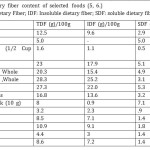 |
Table 1: Dietary fiber content of selected foods.5,6 Click here to View table |
Mechanism of Action
Soluble fiber lowers total and LDL-c cholesterol which can be attributed to enhanced gastric emptying, intestinal binding of bile acids thus reducing entero-hepatic bile recirculation, lowered dietary cholesterol absorption, affects VLDL composition which then contains more amount of phospholipids and less of cholesterol, also improves satiety. It also undergoes fermentation to short chain fatty acids (SCFA) in the colon thus reducing endogenous synthesis of cholesterol. It also decreases dietary glucose absorption thereby down regulating cholesterol synthesizing anabolic hormone insulin release.7-13
Omega-3 Fatty Acid From a Plant Source
They are essential fatty acids for competitive synthesis of eicosonoids which are anti-inflammatory, anti aggregatory and anti-thrombotic in action.14, 15 Additional physiologic functions of omega-3 fatty acids which may prevent ASCVD include several mechanisms such as; maintain fluidity of the cell membrane thus facilitating removal of cholesterol, down regulating phosphotidic acid phosphatase (PAP) and diacylglycerol acyl tranferase (DGAT) thus reducing fatty acid synthesis, also activates PPAR involved in B-oxidation of fatty acids, upregualting lipoprotein lipase (LPL) activity thus increasing fats hydrolysis. N-3 fatty acids also modulate sterol regulating element binding protein (SREBP) and increases degradation of apoprotein B which eventually decreases LDL-c secretion and transport.16-18 Table 2 illustrates nutrient composition of flaxseed.
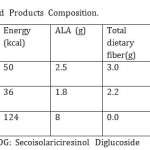 |
Table 2: Various Flaxseed Products Composition Click here to View table |
Phytoestrogens
Area diverse group of naturally occurring non steroidal plant compounds that, because of their structural similarity with estradiol (17-β-estradiol), have the ability to cause estrogenic or/and antiestrogenic effects.20 Phytoestrogen content of selective foods are discussed in Table 3. There are 2 major classes of phytoestrogens including: Isoflavones contains major bioactive components i.e. daidzein and genistein. They are primarily present in soy as much as 3 mg/g dry weight of soy. Lignans and their major bioactive components secoisolariciresinol and matairesinol are primarily found in flaxseeds.21
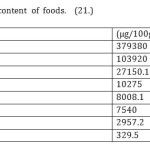 |
Table 3: Phytoestrogens content of foods. Click here to View table |
Mechanism of Action
Clinical evidence suggest that phytoestrogens is effective in lowering serum cholesterol via a series of mechanism which include; up regulation of LDL-c receptor activity thus increasing its clearance, it also depresses the activity of platelet activating factor receptor antagonists eventually reducing oxidation of the lipid, the primary step in process of hypercholesterolemic atherosclerosis. Phytoestrogens also enhances the activity of cholesterol-7 hydoxylase which in turn decreases endogenous cholesterol synthesis. There is also down regulation of the enzyme tyrosine kinase thus reducing thrombin production and ultimately myocardial infarction risk (MI) risk.22-27
Soy Protein
Recently soybeans are considered by many agencies as a source of a complete protein. Hence variety of food such as salad dressings, beverage powders, cheese, infant formulas and others contains soy proteins. The nutritional value of soy protein is equivalent to that of animal protein of high BV. For instance, isolated soy protein has a PDCAAS (Protein Digestibility Corrected Amino Acid Score) of 1.0, which is the same as that of casein and egg protein. 100g of whole soybeans contains 43.2 g of protein.28-30 Biological value of various soy products like whole soybean, soy milk, soy protein isolates are 96.0, 91.0, and 74.0 respectively.31
Mechanism of Action
Various studies have shown that soy proteins effectively lowers cholesterol through series of mechanisms such as; it binds bile acids thus reducing enterohepatic recirculation of bile, it also up regulates the apz B and apo E receptor activity thus reduces serum LDL-c levels. Soy proteins have also shown to reduce HMG-CoA reductase activity, the rate limiting enzyme in cholesterol synthesis and increase cholesterol-7 hydroxylase activity which eventually lowers cholesterol synthesis.31-33
Human Studies
To identify the majority of human studies on cardiovascular effects of these food items we performed a systematic search of the following databases: PubMed, Medscape, MDconsult etc from 1995-2009. We used the headings “soluble fiber, botanical n-3 fatty acids, Phytoestrogens and soy proteins and searched the terms “soy, flaxseeds, oats and psyllium.” Using this strategy we identified 75 relevant articles and book chapters. The description below highlights the information on potential CV application of this food items.
Epidemiological Data
Epidemiological data concerning in take of fiber, n-3fatty acids, phytoestrogens and soy proteins are studied as all the discussed food items are a good sources of this bioactive components. Epidemiological data on dietary fiber and risk of ASCVD are extensive and suggest in general an inverse correlation between them. Several observational trials have found positive correlation between soy proteins and n-3 fatty acids and secondary prevention of ASCVD. Also observational studies revealed that lignans may reduce ASCVD morbidity and mortality. The following section describes data from human studies that addresses the Quantity and Effects of soy, flax, oats and psyllium and their bioactive components on CV risk factors dyslipidemia and others like inflammation, blood pressure and glycemic control.
Bioactive Components Enriched Food Items
Soy
Soy (glycine max) is a species of legume native to East Asia. The beans contain significant amounts of proteins (38%), isoflavones, dietary fiber (25-30%) and phytic acid. The principle carbohydrates (30-32%) of mature soybeans are the disaccharide sucrose (2.5-8.2%), trisaccharde raffinose (0.1-1.0%) and the tetrasaccharide stachyose (1.4-4.1%). The majority of soybean carbohydrates can be classed as belonging to dietary fiber. The Food Drug and Administration (FDA) have approved soy as an official cholesterol-lowering food, along with other heart and health benefits.35 The major bioactive components that are responsible for improving the lipid profile on soy interventions are dietary fiber, phytoestrogens and soy proteins and articles related to these are discussed in table 4.
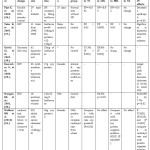 |
Table 4: Interventional trial data on lipid lowering effects of soy Click here to View table |
To Summarize
The bulk of the evidence from five clinical trials (36-41.) suggest that soy proteins (20-40g/d) or soy isoflavones (30-150mg/d) can modestly but significantly (p=<0.05) reduce total and LDL cholesterol in both normal and hypercholesterolemic subjects, without a significant effects on HDL-c and TG’s. Effects were more prominent in post menopausal women or in subjects with initial mild to moderate hypercholesterolemia. Desroches S., et al concluded that soy was also effective in shifting LDL particle size to a less atherogenic pattern. Thus, replacing foods high in saturated fats, trans fats & cholesterol; by soy products containing 30-150 mg/d of isoflavones or 20-40g/d of soy protein have a positive effects against coronary risk factors and related co morbidities e.g.: type 2 DM, hypertension and others.
Flaxseeds
Flaxseed (linseed) is a smooth, flat and reddish-brown in color is native to the region extending from the eastern Mediterranean to INDIA. Whole flaxseeds contain 28% dietary fiber (7-10% soluble fiber, 11-18% insoluble fiber); 40% fats (57% of omega-3 fatty acids) and 21% proteins. it is also the richest source of phtoestrogens-lignans.42 Consumption of flaxseeds have shown to reduce total and LDL cholesterol as well as platelet aggregation (43,44.). The major bioactive components responsible for hypolipidemidic action of flaxseeds are dietary fiber, omega-3 fatty acids and lignans and human trials related to these are discussed in detailed in table 5.
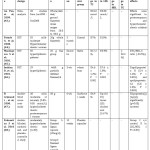 |
Table 5: Interventional trial data on lipid lowering effects of flaxseeds Click here to View table |
To Summarize
The results of the above discussed 5 clinical trials (43-48.) suggest that flaxseeds (20-50g/d whole or partially defatted respectively) are efficacious in improving the lipid profile in both normal and mild-moderate hypercholesterolemic subjects. This can be due to the bioactive components in flax like fiber, n-3 fatty acids and lignans which via several mechanisms as discussed earlier have shown to have a positive association with reductions in serum total and LDL cholesterol. The effects of flax seeds were more prominent in subjects with initial hypercholesterolemia like in postmenopausal women. They have also shown to have beneficial effects on other CVD risk factors like ratios of TC: HDL, LDL: HDL reductions in Apo B 100 and also Lp (A) a strong predictor of CVD. Thus daily incorporation of 20-50g of whole or partially defatted seeds respectively is effective in improving lipid profile.
Oats
Oats most commonly are available as rolled, crushed into oatmeal or ground into oat flour. Oat bran is the outer casing of the oats. Oats contain more soluble fiber as compare to any other grain. The soluble fiber in oats comprises of beta glucan, a class of polysaccharide having mixed linkages. The percentages of beta glucan in various products of whole oats are: oat bran >5.5-23%, rolled oats and oat flour about 4 %. FDA in 1998 approved to claim food products containing 3g of soluble fiber from oats can be labeled as foods reducing risk of heart disease.49 The major bioactive components in oats responsible for lipid lowering seem to be beta glucan as reported by various trials discussed in table 6.
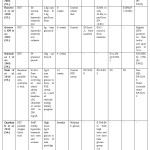 |
Table 6: Interventional trial data on lipid lowering effects of oats Click here to View table |
To Summarize
The results from these studies (50-56.) suggest that oats beta glucan is efficacious in significantly improving lipid profile as it was able to reduce TC and LDL-c in normal as well as hypercholesterolemic subjects significantly (p=< 0.05). Its intervention also significantly increased HDL levels (Villasmil R et al). It was also effective in decreasing LDL: HDL and TC: HDL ratios from the baseline significantly. Queenen et al also found that oats beta glucan is a most fermentable fiber and produces the highest levels of SCFA butyrate compared to inulin and guar gum in vivo. Oat bran also proven to be beneficial in9; premenopausal women as it increased HDL-c levels and reduced LDL and TC levels. Oats was also able to reduce classical CVD risk marker i.e. systolic blood pressure (SBP) significantly (p=0.026) in the trial conducted by Saltzman E et al. thus daily incorporation of 25-150g/d of oats or 2.5-6.0g of beta glucan is effective in the treatment of mild-moderate dyslipidemia.
Psyllium
Psyllium seed husk also known as isabgol are the seeds of plant Plantago otava. They are indigestible by the human intestine, thus helps in holding large amounts of water and making the stools bulky and soft for easy defecation; therefore they are used in the treatment of constipation, Irritable bowel syndrome, diarrhea etc. As early as in 1998, the FDA already have approved a healthy claim on daily incorporation of 3-12grams of psyllium along with a low fat diet may reduce risk of heart disease.57 The hypolipidemic effects of psyllium mucilage have been discussed by various epidemiological studies in table 7.
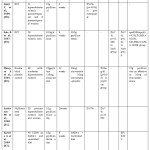 |
Table 7: Interventional trial data on lipid lowering effects of psyllium Click here to View table |
To Summarize
Various human clinical trials on psyllium58-62 suggest that this mucilage enriched food item is effective in lowering total cholesterol, LDL-c, triglycerides and improving the concentrations of good cholesterol HDL-c in the serum of normal and hypercholesterolemic subjects. Also the effects were more prominent in postmenopausal women as concluded by Ganji V et al. Psyllium was also effective in lowering Apo B 100: ApoA1, TC: HDL. LDL: HDL and also increasing conc of Apo A1; the apoprotein of HDL; thus reducing the primary and secondary ASCVD risk factors. Moreyra A, et al also concluded that 15g/d of psyllium intervention was as effective in lowering cholesterol as 20 mg of simvastatin alone. Therefore, psyllium 5-15g/d is an effective adjunct therapy and may provide an alternative to drug therapy for mild-moderate hypercholesterolemic individuals.
Conclusion
Dyslipidemia and ASCVD morbidity is increasing at an alarming rate nationwide and thus it becomes essential to prevent or treat dyslipidemia to regress the associated metabolic derangements. Fortunately today we can combat this situation initially through diet and physical activity before switching on to cholesterol lowering drug therapy. Merely by including the discussed hypolipidemic dietary agents in the required dosage as inferred from researches and recommendations i.e. oats 45-150g/d or beta glucan 2.5-6g/g; 20-25g of soy protein or 30-150mg of isoflavones; flaxseeds 20-50g of whole or partially defatted respectively; psyllium 5-15g per day along with a low fat NCEP followed diet and recommended physical exercise are significantly effective in improving serum lipid profile. The discussed food items may be effective in preventing, reversing or managing most prevalent chronic conditions as mentioned earlier, and hence may be claimed as to be “first line therapy” in dyslipidemia management. They can simply be incorporated in ones daily diet as they are less expensive, readily available, relatively have no side effects, practical and effective in recommended low dosages. They are proven to be more effective in mild-moderate hyperlipidemics like postmenopausal women who are hesitant to follow a life-long drug therapy for improving their mildly deranged lipid profile. This review attempts to not only enlist the effects, possible mechanism and bioactive components of the food item but also to quantify the same to have a desired effect on individual lipid profile.
Limitations
While the majority of the published intervention studies suggest a lipid lowering effects of moderate doses of these food items administration, question remains about the consistency, efficacy, safety and duration of these effects. Future studies will need to clarify the lipid effects in more varied populations (men and premenopausal women).
References
- National Commission on Macroeconomics and Health (NCMH) Background, Current Science, Vol. 97 (2005).
- www.whoindia.org/en/index.
- National Cholesterol Education Program (NCEP) Expert Panel On Detection, Evaluation, and Treatment of High Blood Cholesterol In Adults (Adult Treatment Panel Iii) Final Report, Circulation 106, 31-43(2002).
- AOAC Definition Revised By American Association of Cereal Chemists, 2000.
- Anderson JW, et al., Dietary Fiber Content of Selected Foods; American Journal of Clinical Nutrition vol.47, 440-7 (1988).
CrossRef - C. Gopalan et al. Nutritive value of Indian foods, National Institute of Nutrition; 2011
- Brown Lisa, Bernard Rosner, Walter W Willett and Frank M Sacks. Cholesterol-Lowering Effects of Dietary Fiber: A Meta-Analysis. American Journal Of Clinical Nutrition, Vol. 69, No. 1, 30-42 (1999).
- Anderson JW et al. Dietary Fiber: Hyperlipidemia, Hypertension and Coronary Artery Disease. Am J Gastroenterol, vol 81, issue 10, 907-919(1986).
- Schneeman Bo, Gallaher D. Effects of Dietary Fiber on Digestive Enzyme Activity and Bile Acids In The Small Intestine. Proc Soc Exp Biol Med; 180,409-414(1985).
CrossRef - Jenkins DJ, Newton C, Leeds AR, Cummings JH (1975). Effect of Pectin, Guar Gum, and Wheat Fibre On Serum-Cholesterol. Lancet 1, 1116-1117.
CrossRef - Hillman LC, Peters SG, Fisher CA, Pomare EW. The Effects of the Fiber Components Pectin, Cellulose and Lignin on Serum Cholesterol Levels. Am J Clin Nutr 42, 207-213(1985)
CrossRef - Schneeman BO. Dietary Fiber and Gastrointestinal Function .Nutrition Review 45, 129–32(1987)
CrossRef - Blundell JE, Burley VJ. Satiation, Satiety and the Action of Fiber on Food Intake. Int J Obes (Suppl) 11, 9–25(1987).
- Shearer G, Harris W, Pedersen T, Newman J. Detection of Omega-3 Oxylipins in Human Plasma and Response to Treatment with Omega-3 Acid Ethyl Esters. J Lipid Res. 51, 2074-2081(2009)
CrossRef - Holman R. The Slow Discovery of the Importance of Omega 3 Essential Fatty Acids in Human Health. J. Nutr. 128 (2 Suppl), 427s–433s(1998)
- Sanders T, Oakley F, Miller G, et al .Influence Of N-6 Versus N-3 Polyunsaturated Fatty Acids In Diets Low In Saturated Fatty Acids On Plasma Lipoproteins And Hemostatic Factors. Arterioscler Thromb Vasc Biol. 17, 3449–3460 ( 1997)
CrossRef - Harris W, Connor W, Alam N, et al.. Reduction of Postprandial Triglyceridemia in Humans by Dietary N-3 Fatty Acids. J Lipid Res. 29, 1451–1460(1988)
- K.Prasad et al..Dietary Flax Seed in Prevention of Hypercholesterolemic Atherosclerosis. Atherosclerosis 132(1), 69-76(1997)
CrossRef - Canadian Grain Commission. Nutritional profile of No. 1 Canada Western flaxseed and of yellow flaxseed samples. Canadian Grain Commission, Winnipeg, MB, 2001.
- Yildiz, Fatih. Phytoestrogens in Functional Foods. Taylor & Francis Ltd. Pp. 3–5, 210-211 (2005)
CrossRef - Thompson L, Boucher B, Liu Z, Cotterchio M, Kreiger N. Phytoestrogen Content of Foods Consumed In Canada, Including Isoflavones, Lignans, and Coumestan. Nutrition and Cancer 54 (2), 184–201(2006)
CrossRef - Sacks F, Lichtenstein A, Van Horn L, Harris W, Kris-Etherton P, Winston M. Soy Protein, Isoflavones, and Cardiovascular Health: An American Heart Association Science Advisory for Professionals from the Nutrition Committee. Circulation 113 (7): 1034–44(2006)
CrossRef - Turner J, Agatonovic S, Glass B. Molecular Aspects of Phytoestrogen Selective Binding at Estrogen Receptors. J Pharm Sci 96 (8), 1879–85(2007).
CrossRef - Crouse J, Morgan Tm, Terry J, Ellis J, Vitolins M, Burke G. A Randomized Trial Comparing The Effect Of Casein With That Of Soy Protein Containing Varying Amounts Of Isoflavones On Plasma Concentrations Of Lipids And Lipoproteins. Arch Intern Med.159, 2070–2076(1999)
CrossRef - Wangen K, Duncan A, Xu X, Kurzer M. Soy Isoflavones Improve Plasma Lipids In Normocholesterolemic And Mildly Hypercholesterolemic Postmenopausal Women. Am J Clin Nutr. 73, 225–231(2001)
- Goodman-Gruen D, Kritz-Silverstein D. Usual Dietary Isoflavone Intake Is Associated With Cardiovascular Disease Risk Factors In Postmenopausal Women. J Nutr. 131, 1202–1206(2001)
CrossRef - De Kleijn Mjj, Van Der Schouw Yt, Wilson Pwf, Grobbee De, Jacques Pf. Dietary Intake Of Phytoestrogens Is Associated With A Favorable Metabolic Cardiovascular Risk Profile In Postmenopausal Us Women: The Framingham Study. J Nutr. 132 no. 2 276-282 (2002)
CrossRef - FAO/WHO Protein Quality Evaluation Report Of Joint FAO/WHO Expert Consultation, Food And Agriculture Organization Of The United Nations, FAO Food And Nutrition Paper No. 51, Rome. (1991)
- Schaafsma, G.. The Protein Digestibility-Corrected Amino Acid Score. Journal Of Nutrition 130, 1865s-1867s. (2000)
CrossRef - Protein Quality-Report Of Joint FAO’/WHO Expert Consultation, Food And Agriculture Organisation, Rome, Fao Food And Nutrition Paper 51, 1991.
- Frank M. et al. Soy Protein, Isoflavones, And Cardiovascular Health. Circulation 113, 1034-1044. ( 2006)
CrossRef - Anderson J, Johnstone B, Cook-Newell M. Meta-Analysis of The Effects Of Soy Protein Intake On Serum Lipids. N Engl J Med 333, 276–282. (1995)
CrossRef - Carroll K. Review of Clinical Studies on Cholesterol-Lowering Response to Soy Protein. J Am Diet Assoc 91, 820-827. (1991)
- Washburn, Scott; Burke, Gregory L.; Morgan, Timothy; Anthony, Mary,. Effect of Soy Protein Supplementation on Serum Lipoproteins, Blood Pressure, and Menopausal Symptoms in Perimenopausal Women. Menopause 6(1), 7-13. (1999)
CrossRef - http://www.accessdata.fda.gov/scripts/cdrh/cfdocs/cfcfr/CFRSearch.cfm?fr=101.82; Accessed on 25th July, 2013
- Pipe Elizabeth A et al..Soy Protein Reduces Serum LDL Cholesterol And The LDL Cholesterol:HDL Cholesterol And Apo lipoprotein B:Apolipoprotein A-I Ratios In Adults With Type 2 Diabetes . J. Nutr 139(9), 1700-06. ( 2009)
CrossRef - Taku K et al.. Soy Isoflavones Lower Serum Total And LDL Cholesterol In Humans: A Meta-Analysis Of 11 Randomized Controlled Trials. American Journal Of Clinical Nutrition 85(4), 1148-1156. (2007)
- 38. Clerici C et al.. Pasta Naturally Enriched With Isoflavone Aglycons From Soy Germ Reduces Serum Lipids And Improves Markers Of Cardiovascular Risk. J. Nutr. 137, 2270-2278. (2007)
CrossRef - 39. Desroches S et al. Soy Protein Favorably Affects Ldl Size Independently Of Isoflavones In Hypercholesterolemic Men And Women. J. Nutr. 134, 574-579. (2004).
CrossRef - Wangen K, et al. Soy Isoflavones Improve Plasma Lipids In Normocholesterolemic And Mildly Hypercholesterolemic Postmenopausal Women. American Journal of Clinical Nutrition 73(2), 225-231. (2001).
- Wofford MR et al. Effect of soy and milk protein supplementation on serum lipid levels: a randomized controlled trial. European Journal of Clinical Nutrition 66, 419–425(2012)
CrossRef - Flax Nutrition Profile Analyzed By the American Oil Chemists’ Society (AOCS) Analysis by American Oil Chemist’s Society (AOCS) Official Method Am 2-93 (2008.)
- 43. Pan A., Danxia Yu, Wendy Demark-Wahnefried, Oscar H Franco And Xu Lin. Meta-Analysis of the Effects Of Flaxseed Interventions On Blood Lipids. Am J Clin Nutr 90, 288-297. (2009)
CrossRef - Patade A, et al Flaxseed Reduces Total and LDL Cholesterol Concentrations in Native American Postmenopausal Women. Journal of Women’s Health 17 (3), 355-366. (2008).
CrossRef - Mandaşescu S, Mocanu V, Dăscaliţa Am, Haliga R, Nestian I, Stitt Pa, Flaxseed Supplementation In Hyperlipidemic Patients. Rev Med Chir Soc Med Nat Lasi, 109 (3), 502-6. (2005).
- 46. Jenkins DJ, et al.. Health Aspects of Partially Defatted Flaxseed, Including Effects on Serum Lipids, Oxidative Measures, And Ex Vivo Androgen and Progestin Activity: A Controlled Crossover Trial. American Journal of Clinical Nutrition 69 (3), 395-402. (1999)
- Arjmandi, B.H et al. Whole Flaxseed Consumption Lowers Serum Ldl-Cholesterol And Lipoprotein (A) Concentrations In Postmenopausal Women. Nutrition-Research 18(7), 1203-1214. (1998).
CrossRef - Fukumitsu S et al. Flaxseed lignan lowers blood cholesterol and decreases liver disease risk factors in moderately hypercholesterolemic men. Nutrition Research 30, 441–446(2010)
CrossRef - FDA/CFSAN A Food Labeling Guide: Appendix C Health Claims, April 2008, Accessed on 25th July, 2013
- Villasmil R et al,. Oat-Derived [Beta]-Glucan Significantly Improves HDL-c And Diminishes LDL-c And Non-HDL Cholesterol In Overweight Individuals With Mild Hypercholesterolemia. American Journal of Therapeutics 14(2), 203-212. (2007)
CrossRef - 51. Saltzman E. et al. An Oat-Containing Hypocaloric Diet Reduces Systolic Blood Pressure and Improves Lipid Profile Beyond Effects of Weight Loss In Men And Women. Journal of Nutrition 131, 1465-1470. (2001).
CrossRef - Romero A, et al.. Cookies Enriched With Psyllium Or Oats Lower Plasma LDL Cholesterol In Normal And Hypercholesterolemic Men From Northern Mexico. Journal Of The American College Of Nutrition 17(6), 601-608. (1998)
CrossRef - Queenen K, et al..Concentrated Oats Beta Glucan, A Fermentable Fiber Lowrs (2007)Cholesterol in Hypercholesterolemic Adults in a Randomized Control Trial. Nutrition Journal 6, 525-524.
- Robitaille J. et al,. Effect of an Oat Bran-Rich Supplement on the Metabolic Profile of Overweight Premenopausal Women. Ann Nutr Metab 49, 141-148. (2005)
CrossRef - Maki et al. Whole-Grain Ready-to-Eat Oat Cereal, as Part of a Dietary Program for Weight Loss, Reduces Low-Density Lipoprotein Cholesterol in Adults with Overweight and Obesity More than a Dietary Program Including Low-Fiber Control Foods. J Am Diet Assoc.;110:205-214. 2010
CrossRef - Charlton K et al. Effects of 6 weeks consumption of B-glucan rich oat products on cholesterol levels in mildly hypercholesterolemic overweight adults. British Journal of Nutrition, 107; 1037-1047(2012)
CrossRef - http://www.accessdata.fda.gov/scripts/cdrh/cfdocs/cfcfr/CFRSearch.cfm?fr=101.81, Accessed on 25th July, 2013
- Ganji Vijay and Jennifer Kuo. Serum Lipid Responses to Psyllium Fiber: Differences between Pre- and Post-Menopausal Hypercholesterolemic Women. Nutrition Journal 7(22) 7-22. (2008)
- Solà R, et al.. Effects of Soluble Fiber (Plantago Ovata Husk) On Plasma Lipids, Lipoproteins, and Apolipoproteins in Men with Ischemic Heart Disease. American Journal of Clinical Nutrition 85(4), 1157-1163. (2007)
- Moreyra AE et al. Effect of Combining Psyllium Fiber with Simvastatin in Lowering Cholesterol. Archicves of Internal Medicine 165 (10), 1161-1166. (2005).
CrossRef - Anderson J W, et al. Long-Term Cholesterol-Lowering Effects of Psyllium as an Adjunct to Diet Therapy In The Treatment Of Hypercholesterolemia. American Journal of Clinical Nutrition 71(6), 1433-1438
- Sartore G et al. The effects of psyllium on lipoproteins in type II diabetic patients. European Journal of Clinical Nutrition (2009) 63, 1269–1271(2000).

This work is licensed under a Creative Commons Attribution 4.0 International License.




